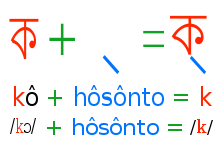Bengali/Script/Consonants 1
Plosives
[edit | edit source]This page will introduce the first twenty-five consonants of the Bengali language, namely, the plosives (স্পর্শ বর্ণ spôrsô bôrno, IPA : /spɔrso bɔrno/), since they are easier to learn at first. The Bengali plosives are subdivided into five classes, according to their place of articulation.
| Consonant class (বর্গ, borgo, /bɔrgo/) | 1st consonant (voiceless, not aspirated) | 2nd consonant (voiceless, aspirated) | 3rd consonant (voiced, not aspirated) | 4th consonant (voiced, aspirated) | 5th consonant (nasal) |
|---|---|---|---|---|---|
| ক-বর্গ (ka-barga, /kɔ bɔrgɔ/), Velars | ক /k/ | খ /kʰ/ | গ /g/ | ঘ /gʱ/ | ঙ /ŋ/ |
| চ-বর্গ (ca-barga, /t͡ʃɔ bɔrgɔ/), Palatals2 | চ /t͡ʃ/ | ছ /t͡ʃʰ/ | জ /d͡ʒ/ | ঝ /d͡ʒʱ/ | ঞ /n/1 |
| ট-বর্গ (ṭa-barga, /ʈɔ bɔrgɔ/), Retroflexes | ট /ʈ/ | ঠ /ʈʰ/ | ড /ɖ/ | ঢ /ɖʱ/ | ণ /n/1 |
| ত-বর্গ (ta-barga, /t̪ɔ bɔrgɔ/), Dentals | ত /t/ | থ /tʰ/ | দ /d/ | ধ /dʱ/ | ন /n/1 |
| প-বর্গ (pa-barga, /pɔ bɔrgɔ/), Bilabials | প /p/ | ফ /pʰ/, /ɸ/, or /f/3 | ব /b/ | ভ /bʱ/ or /β/3 | ম /m/ |
^1 ঞ, ণ and ন used to have different sounds in earlier Bengali, but in modern Bengali they all sound like the dental /n/.
^2 The palatals are not actually palatal sounds in Bengali anymore. Instead, they are more or less Affricates.
^3 ফ and ভ are usually pronounced as bilabial aspirates, /pʰ/ and /bʱ/. However, in modern Bengali, they are also pronounced as bilabial fricatives /ɸ/ and /β/. ফ can also correctly be and is widely pronounced as /f/ due to the influence Arabic, Persian, and English, languages which provided Bengali and other Indian languages with many loanwords containing the /f/-sound, left in Bengali. The /f/ pronunciation is (and has already, for many speakers) replacing the original /pʰ/ pronunciation even in native words, especially in urban areas and among young people.
Hosonto ( ্ )
[edit | edit source]
The hasanta (হসন্ত, IPA: /ɦɔʃɔnt̪o) is a diacritic looking like a diagonal tick mark going from north-west to south-east direction. In Bengali, all consonants are pronounced with an inherent অ (/ɔ/), so ক is actually pronounced /kɔ/). Adding the hasanta means that you are removing that অ (/ɔ/). Therefore ক্ is simply /k/. It is worthwhile to mention that ka is the name of ক. In this way, all the consonants are named. An exception to this is the consonant জ, which is called বর্গীয়-জ (bargiiya-ja, /borgi̯o‿dʒɔ/) in order to distinguish them from the য, which is called অন্তঃস্থ-য (antaḥstha-ya, /on̪t̪ɔst̪ʰɔ dʒɔ/) mentioned in Consonants, Part Two.
Aspirates
[edit | edit source]One special feature of the Bengali alphabet is the presence of letters representing both aspirated and unaspirated consonants. This is in contrast to English, which only has letters for unaspirated consonants in its alphabet, Although English does have aspirated sounds. Notice the difference between pill and spill. In the former case, the p in pill is aspirated, while in spill it is not. The aspirated consonants (i.e., খ, ঘ, ছ, ঝ, ঠ, ঢ, থ, ধ, ফ, ভ) are pronounced just the same as their unaspirated counterparts ক, গ, চ, জ, ট, ড, ত, দ, প and ব except for the presence of a strong breath just after the consonant. While pronouncing খ্, it almost sounds like ক্ + হ্.
Wa-phalaa
[edit | edit source]When ব comes after a consonant in a conjunct, it is changed to the ব-ফলা (wa-phalaa, /bɔ pʰɔla/), ্ব.
Examples : শ্বাপদ (shwaapad, /ʃapɔd̪/, "a dangerous animal which is carnivorous"), কাণ্বকুব্জ (kaaṇwakubja, /kannokubdʒo/, "an ancient Indian city"). In the first example, the wa-phalaa is absent, while in the second, it doubles the /n/. Note that কাণ্বকুব্জ contains two conjuncts, ণ্ব (ণ্ + ব) and ব্জ (ব্ + জ). The former becomes a wa-phalaa while the second does not.
Bibliography
[edit | edit source]Bengali alphabet — English Wikipedia
Aspirated consonants — English Wikipedia